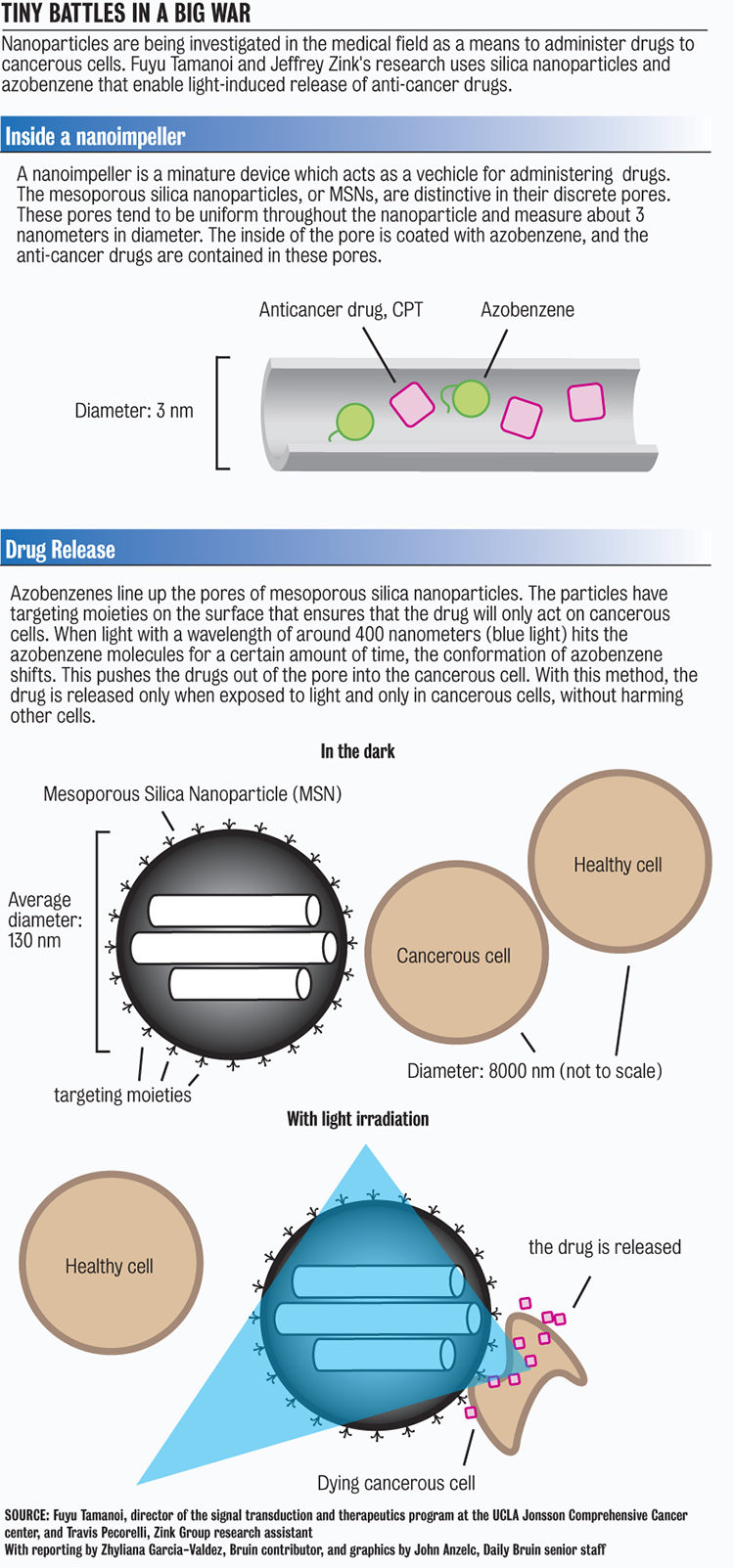Self-replicating robots and cures for cancer may seem unrelated, but nanotechnology brings these two subjects into a research field with very promising results.
Current nanotechnology research at UCLA involves developing nanoparticles that fight cancer cells, and experts say we will see nanomachines building other nanomachines in the future.
Nanotechnology is a rising field in science that involves the manufacture of microscopic particles that usually measure 100 nanometers or less, said Chris Phoenix, director of the Center for Responsible Nanotechnology, a nonprofit research and advocacy organization focusing on the effects of nanotechnology.
Nanotechnology takes advantage of the changes in physical properties that occur when the quantities of a material are very small. These changes in properties have come to be popularly known as quantum physics.
Many medical applications of nanotechnology focus on cancer treatments, Phoenix said. At UCLA’s Jonsson Comprehensive Cancer Center, Fuyu Tamanoi is the director of the signal transduction and therapeutics program. He is further developing nanoimpellers, a special type of nanoparticles that received much attention a year ago for its success at carrying anti-cancer drugs to targeted cells in vitro.
Today, Tamanoi builds upon that landmark to bring the research in vivo, or to a living organism. Tamanoi is also co-director for the Nano Machine Center for Targeted Delivery and On-Demand Release at the California NanoSystems Institute. Other directors of the Nano Machine Center are Jeffrey Zink, Andre Nel and Fraser Stoddart.
“The greatest issue in cancer treatments right now is the controlled release of drugs only in response to external stimuli,” Tamanoi said.
In theory, these nanoparticles are delivered to patients inside tissue diagnosed with a cancerous tumor. Once inside the body, the particles, carrying within them anti-cancer drugs, target these cancerous cells, Tamanoi said. The particles are then activated by light exposure to releasing the drugs within them and the cell dies, Tamanoi added.
Currently, this concept is explored at the Tamanoi Lab. In 2008, Tamanoi’s and Zink’s research culminated in a silica mesoporous nanoparticle that releases its contents in an aqueous or biological environment. The pores in this silicate nanoparticle contain anti-cancer drugs that are expelled from the pores when azobenzene, which coats the interior of the particle’s pores, is exposed to blue light and moves.
This movement of the molecules “pushes the drugs out of the pores like a bat,” said Travis Pecorelli, a member of the Zink research group, which collaborates with Tamanoi.
Using this technique, Tamanoi has been able to successfully deliver anti-cancer drugs to pancreatic and colon cancer cells in vitro. Currently, Tamanoi is conducting research in tumors in vivo. The potential delivery methods of these nanoparticles include intravenous injection and oral capsules. According to Tamanoi, intravenous injections seem the most promising.
Researchers hope for this research to someday become a standard cancer treatment. Phototherapy, as the Center for Responsible Nanotechnology has named the process, will deliver several small doses in several sessions. The dosage can then be controlled through light intensity and exposure time, according to the Tamanoi Lab.
Of course, nanotechnology brings forth a number of potential dangers along with the hope of better cancer treatments. The dangers involving any application of nanoscale technology compare to those of any other research field with unstudied products, Phoenix said.
Nanotechnology is developing chemicals that scientists have not studied enough to ensure their safety, Phoenix said.
“Within a decade, I see nanotechnology developing a nanomachine that is able to replicate a completely functional copy of itself from fragments of other molecules,” Phoenix added. “When machine builds machine, the implications become more dangerous.”
Still, Tamanoi believes research in nanotechnology holds potential benefits. “I think, when it comes to medical advancements in nanotechnology,” Tamanoi said, “UCLA is definitely one step ahead of everybody else.”
